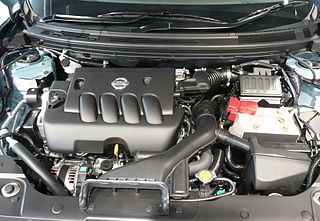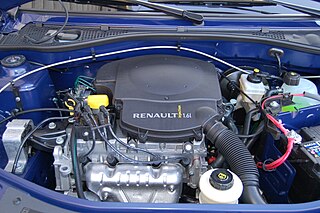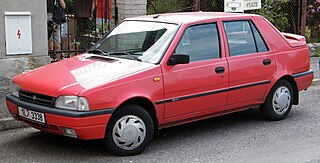
The straight-six engine is a piston engine with six cylinders arranged in a straight line along the crankshaft. A straight-six engine has perfect primary and secondary engine balance, resulting in fewer vibrations than other designs of six or fewer cylinders.

The V6 PRV engine is an overhead cam V6 automobile engine designed and manufactured by the company "Française de Mécanique" for PRV, an alliance of Peugeot, Renault and Volvo Cars. Sold from 1974 to 1998, it was produced in four displacements between 2.5 L and 3.0, and in both SOHC and DOHC and 2-valve and 4-valve per cylinder configurations. Originally carbureted, it adopted fuel-injection for improved emissions compliance and improved performance, and was offered in turbo and biturbo versions in a limited number of vehicles made by Renault, Chrysler Motors, and French supercar manufacturer Venturi.

The Renault Clio is a supermini (B-segment) car, produced by French automobile manufacturer Renault. It was launched in 1990, and entered its fifth generation in 2019. The Clio has had substantial critical and commercial success, being consistently one of Europe's top-selling cars since its launch, and it is largely credited with restoring Renault's reputation and stature after a difficult second half of the 1980s. The Clio is one of only two cars, the other being the Volkswagen Golf, to have been voted European Car of the Year twice, in 1991 and 2006.

The Ford CVH engine is a straight-four automobile engine produced by the Ford Motor Company. The engine's name is an acronym for either Compound Valve-angle Hemispherical or Canted Valve Hemispherical, where "Hemispherical" describes the shape of the combustion chamber. The CVH was introduced in 1980 in the third generation European Escort and in 1981 in the first generation North American Escort.

The Renault 9 and Renault 11 are small family cars produced by the French manufacturer Renault from 1981 to 1989 in saloon and hatchback configurations — both were styled by the French automobile designer, Robert Opron.

The Renault 19 is a small family car that was produced by the French car manufacturer Renault between 1988 and 1996. In Turkey and in Argentina, production continued until 2000. The internal development code for the 19 was X53, with the five door receiving the B53 chassis code, the three door being the C53, the Chamade the L53, and the Cabriolet the D53.

The Renault Twingo is a city car made by the French company Renault since 1992 across three generations. The name is a portmanteau of twist, swing, and tango.

The Billancourt engine was an automotive engine designed by Renault for the Renault 4CV, used subsequently until 1985. It later received the internal code "B", for Billancourt. The "sport" version is called Ventoux engine.

The Renault-Nissan MR engine family consists of straight-four 16-valve all-aluminium and water cooled automobile engines with variable valve timing co-developed by Renault and Nissan. Renault calls it the M engine. Other noteworthy features of this engine family include acoustically equal runner lengths and a tumble control valve for the intake manifold, a "silent" timing chain, mirror finished crankshaft and camshaft journals, and offset cylinder placement in an attempt for increased efficiency.

The PSA X engine is a family of internal combustion engines used in Citroën, Peugeot, Talbot and Renault automobiles. The X family was mainly used in superminis and the entry-level models of midsize vehicles. It was designed and manufactured by the company "Française de Mécanique", a joint venture created by Peugeot and Renault in 1969, and built in Douvrin in northern France. It is commonly called the "Suitcase" engine, the "Douvrin" nickname being commonly used for the bigger 2.0–2.2-liter J-Type engine, which was also built in Douvrin.

The HR is a family of straight-3 12-valve and straight-4 16-valve automobile engines with continuously variable valve timing, involving development by Nissan and/or Renault, and also Mercedes-Benz in the case of the H5Ht/M282. The designation of H engine is used by Renault, and M28x by Mercedes-Benz, to classify the family. There are three basic specifications of engine involving variations in engine architecture, or all-new architecture, with 72.2 mm (2.84 in), 75.5 mm (2.97 in) and 78 mm (3.07 in) bore diameter.

The Cléon-Fonte engine is a family of inline four-cylinder automobile engines developed and manufactured by Renault. It has also been called the Sierra engine, the C-engine, or the C-Type. It has been in continuous production by Renault or a licensee from 1962 to 2004. After about three decades of use in Renault's compact models, it was gradually replaced by the E-type engine from the late 1980s onward.

The Renault DiET engine also known as "D engine" or "D-Type" is a straight-4 automobile petrol engine from Renault designed to replace the existing Cléon-Fonte engine in the Renault Twingo.

F Renault engine is an automotive internal combustion engine, four-stroke, inline-four engine bored directly into the iron block, water cooled, with overhead camshaft driven by a timing belt, and with an aluminum cylinder head, developed and produced by Renault in the early '80s, making its appearance on the Renault 9 and 11. This engine is available in petrol and diesel versions, with 8 or 16 valves.

The Cléon-Alu engine, also known under the code "A engine" or "A-Type" is an automotive gasoline internal combustion engine, developed and produced by Renault in 1960. A four-stroke inline four-cylinder design with aluminium-alloy block and cylinder head, it was water cooled, with a five main bearing crankshaft and a side-mounted chain-driven camshaft operating eight overhead valves via pushrods and rockers. It made its debut appearance on the Renault 16.

The K-Type is a family of inline-4 automobile engines developed and produced by Renault since 1995. This is an internal combustion engine, four-stroke, with 4 cylinders in line bored directly into the iron block, water cooled, with overhead camshaft(s) driven by a toothed timing belt and an aluminium cylinder head. This engine is available in petrol and diesel versions, with 8 or 16 valves.

The R-Type is a family of straight-4 turbocharged diesel engines developed by both Nissan and Renault, and also Daimler in regarding the R9M/OM626 engine. Released in 2011, it replaced the 1.9 dCi engine in Renault's range and the 2.0 dCi in the Nissan Qashqai, and in 2015, it also replaced the 2.0 dCi in the Renault Mégane as well. When launched, the engine produced 130 PS. Renault later introduced a higher-powered twin-turbocharged variant producing 160 PS.

The Dacia SupeRNova was a subcompact/supermini car manufactured by Romanian auto manufacturer Dacia from the year 2000 to 2003.

The M281 is a straight-three petrol engine produced by Mercedes-Benz since 2014.




















